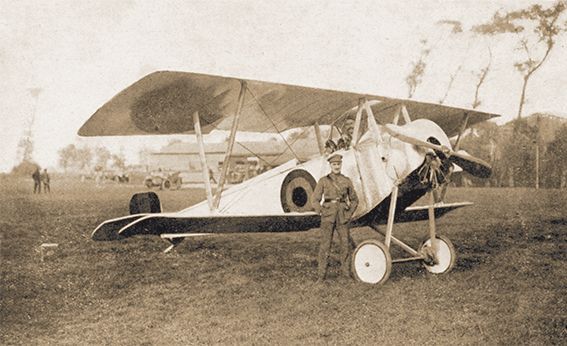
Jules Tyck posing with 'his' Nieuport.
“The Great War” (1914-1918)
At the flying school of Bollekens in Sint-Job, the training of military pilots continued unabated. After all, there was a conflict in the air...
At the outbreak of the First World War, a number of pilots put themselves at the disposal of the military government with their equipment. The Bollekens company follows the retreating army with all its equipment and personnel and will maintain the military aircraft during the war.
In August 1914, the First World War broke out. The planes and equipment of the flight schools of Sint-Job and Kiewit are regrouped in the “impregnable” fortress of Antwerp. For this purpose, the training area of the Genie “de Wilrijckse Plein” will be set up as an airfield. The four Belgian squadrons with JEROs do a lot of good reconnaissance work. The army command is finally starting to see the usefulness of aviation. Civilian pilots such as the Caters, Jan and Max Olieslagers, the Orta brothers and Jules Tyck volunteer with their own equipment. The Bollekens factories are expanding to meet the demand for new appliances and repairs to existing ones. They also maintain the aircraft of the Allies and find that their own designs are more solid and much more modern.
In October 1914 the situation in Antwerp became untenable and the soldiers had to evacuate. All of Bollekens' material is loaded onto a special military train and forty employees with their wives and children are taken to Ostend and later via the Westhoek to Le Havre. They continued to maintain and build military aircraft until 1916. Then suddenly the cooperation is unilaterally canceled by the military and the technicians have to be dismissed. Some find work with foreign constructors. After the war, the Bollekens brothers return to Antwerp, only to discover that their workhouses have been destroyed by the Germans. A trial against the Belgian State that would drag on for thirty years ultimately failed to produce a positive outcome. The end of the war was also the end of an aircraft manufacturer that was ahead of its time.
Photo captions (top-left to bottom-right)
- The Antwerp pioneers Tyck (3rd from the left) and Olieslagers (2nd from the right) and their comrades for the Blériot van Olieslagers. (coll. Frans Mielants)
- Willy Coppens, our most famous pilot from WWI (coll. Dirk Buytaert)The bow cannot always be tense. Oilers on a rest, but near his Nieuport. (coll. Frans Mielants)
- At the start of the war, bombs were dropped by hand above the target. (coll. Frans Mielants)
- Flying in the winter months with an open cockpit required appropriate clothing. Olieslagers and his observer wrapped up nicely for an upcoming flight. (coll. Frans Mielants)
- King Albert I visits the pilots on an airfield behind the front. (coll. Frans Mielants) Jan Olieslagers and his Sopwith Camel. (coll. Dirk Buytaert)
Stampe en Vertongen Museum vzw
Antwerp International Airport
Bus 3
B-2100 Antwerp-Deurne
Belgium
O.N. BE0447.236.613
RPR Antwerp
email: stampe@skynet.be
www.stampe.be
Opening hours individual visits
- Mon - Fri
- Closed
- Sat - Sun
- -
Closed on Easter Sunday and during August, December and January
Useful links
All rights reserved | Stampe en Vertongen Museum vzw






